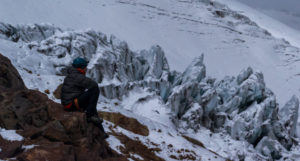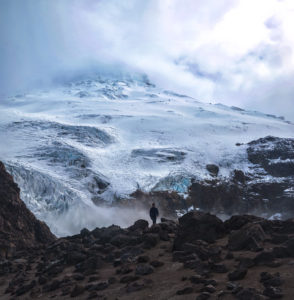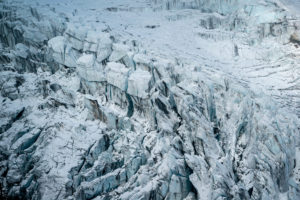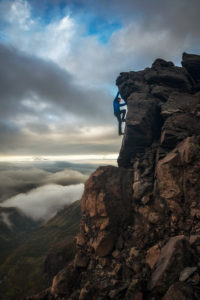Climbing Cayambe with Nick Lake
Nick Lake is a photographer, outdoorsman, and adventurist. He’s journeyed all over the world to capture unique images and tell stories of our amazing planet. Recently, Nick explored Cayambe, Ecuador’s third-tallest peak and the world’s highest point along the Equator. Below Nick describes his latest adventure in his own words.
No matter how you slice it, alpine starts are brutal. It doesn’t matter how early you went to bed—chances are you didn’t sleep well anyways, whether due to the elevation, too much whiskey, snoring bunk or tent mates, or good old-fashioned nerves. As I laid down the night before my first stratovolcano climb, I was surprised to find my bunk plush, my roommates quiet sleepers, and my body well acclimatized. It was a mix of anxiety about crevasses, whiteouts, and Cerebral Edema, along with a healthy dose of excitement about watching the sunrise from 19,000 above sea level that kept me snapping back into consciousness every hour on the hour. Before I knew it, it was midnight and my alarm was chirping in my ear.

Cayambe is Ecuador’s third-tallest peak and the world’s highest point along the Equator. At 18,996 feet high, it occupies a substantial portion of the country’s largest ecological reserve, Cayambe-Coca, which spans high-Andean paramo, remote cloud forest, and the western reaches of the Amazon rainforest. The active volcano sports a hefty glacier and isn’t shy about quaking. In fact, a week before our arrival a series of tremors shook loose a snow bridge just below the summit forcing guides to establish a new, much longer route to the top.
Our plan was to spend a day and a half at the Refugio Cayambe—a climber’s hut perched at 15,092 feet on a muddy arm over looking a massive moraine—practicing crevasse rescue and glacier travel skills before beginning our summit bid at midnight of our second night. Though we arrived to dense fog and clouds, the skies cleared at sunset and we quickly decided we’d make an attempt on our first night to try and take advantage of the weather window. We packed our bags and climbed into bed around 7:30 pm to a brilliant full moon hovering overhead.

As my alarm sounded I popped out of my bunk and quickly threw my things together, checking one last time to ensure I had the essentials: extra layers, crampons, ice axe, harness, plenty of snacks and water, sunglasses and GPS watch. I stepped out into the early morning cold and noticed a menacing deck of clouds on the northern horizon. Though we could still see the moon overhead it hung now diffuse, like a flashbulb behind a screen. With few words we began our climb along the sandy bench, the terminus of the glacier in our sights just a mile away. Though we’d made good progress, so had the clouds to the north and, as we sat to put on crampons and rope up, a heavy fall of graupel began pelting us on our faces and ungloved hands. We waited a few minutes but it just got heavier and heavier, accompanied by an ever-increasing wind, so we made the choice to bail and try again the next night.
Graupel and snow turned to rain and sleet as the sun rose and we spent much of the next day doing what any climbers waiting for a weather window do: try not to go crazy. There are only so many games you can play, naps you can take, times you can check your bag to make sure you’ve got everything. Even the most fun group of people (which I assure you we were) can only keep each other entertained for so long in a hut without electricity. By late afternoon, I couldn’t wait for bedtime.

We woke again at midnight, this time to a mix of clouds and moonlight, but much calmer conditions overall. Again we trudged over talus and sand for a mile to the glacier’s entry point where, under still-open skies, we roped up, put on our crampons and started the true ascent. Immediately, azure crevasses yawned on either side of us as our guide, Marco, picked his way along the route. Occasionally he stopped to check an ice bridge before telling us where to step to avoid plunging in. We found our rhythm quickly and arrived at a broad bench just below the final summit block in what seemed like no time. At 17,500 feet it was a good place to regroup, assess conditions and make sure everyone was on the same page for the summit push.

Unfortunately, for the last 200 feet or so of elevation gain, I’d begun to notice a collapsing snow layer underfoot. Marco had noticed as well and an earnest discussion in Spanish had begun with the other guides as we broke for snacks and water. I watched Marco begin to dig a rudimentary avalanche test pit and my stomach dropped as a five-inch-thick slab slid off on only his second or third strike. Our suspicions were confirmed: avalanche danger was very high at this elevation and the slopes we’d be ascending to the summit were prime to slide. Worse, the runout on the summit block consists of some huge crevasses dozens of meters deep. For the second time in 24 hours, we decided to call it.
I like to think I’m immune from the bad decision making to which many outdoorspeople are susceptible, but I often still find myself second-guessing or lamenting decisions to turn back shy of my objectives, even in situations like this one, where the risks were so clear and present. As I plunge stepped down the lower glacial face I found myself questioning whether we really should have turned back, trying to justify a decision to continue, falsely mitigating the risk in my head. The finality of our decision really hit me as I unstrapped my crampons at the glacier’s toe and set my boots back on terra firma. It was a strange feeling of satisfaction with our good heuristics and responsible decision-making and utter disappointment with our second failure in as many days. But as we bumped our way down the washed-out road back to Quito my disappointment faded, along with the mountain, into a mystical Andean fog. I’d already started planning my return trip.
Learn even more about Nick’s adventures here and stay tuned for more amazing content from @NickrLake on social media. Don’t forget to share with us on Facebook, Twitter, Instagram and use #HaveNoLimits.
The post Climbing Cayambe with Nick Lake appeared first on Garmin Blog.
Sample Block Quote
Praesent vestibulum congue tellus at fringilla. Curabitur vitae semper sem, eu convallis est. Cras felis nunc commodo loremous convallis vitae interdum non nisl. Maecenas ac est sit amet augue pharetra convallis nec danos.
Sample Paragraph Text
Praesent vestibulum congue tellus at fringilla. Curabitur vitae semper sem, eu convallis est. Cras felis nunc commodo eu convallis vitae interdum non nisl. Maecenas ac est sit amet augue pharetra convallis nec danos dui.
Cras suscipit quam et turpis eleifend vitae malesuada magna congue. Damus id ullamcorper neque. Sed vitae mi a mi pretium aliquet ac sed elitos. Pellentesque nulla eros accumsan quis justo at tincidunt lobortis denimes loremous. Suspendisse vestibulum lectus in lectus volutpat, ut dapibus purus pulvinar. Vestibulum sit amet auctor ipsum.

